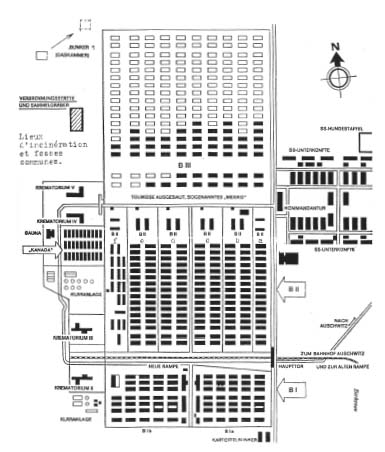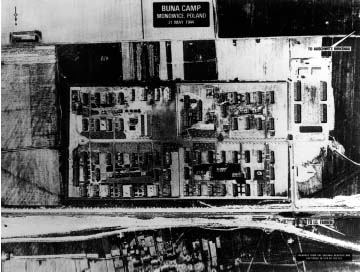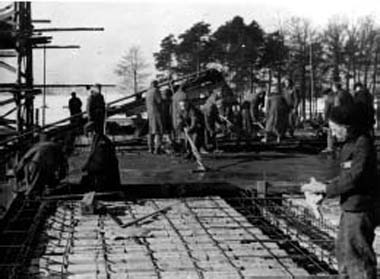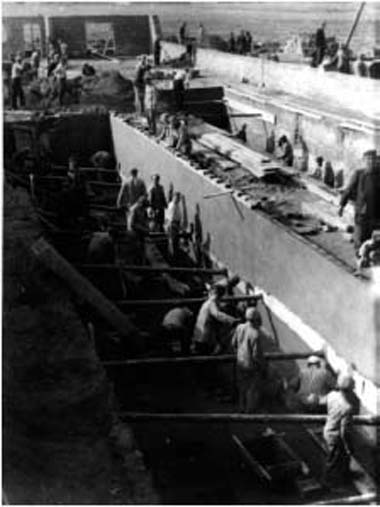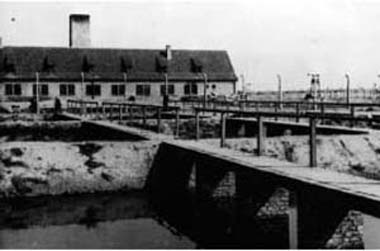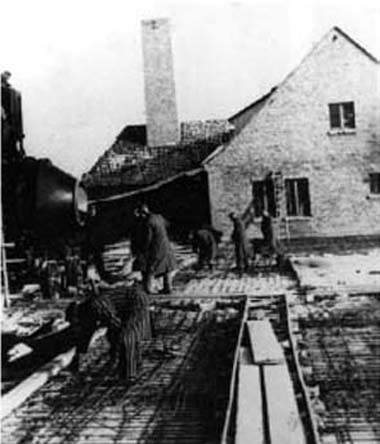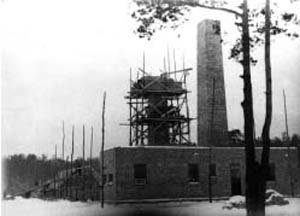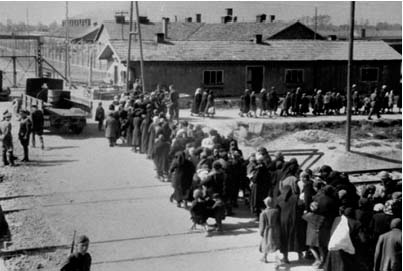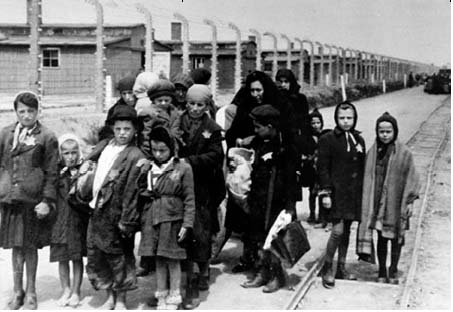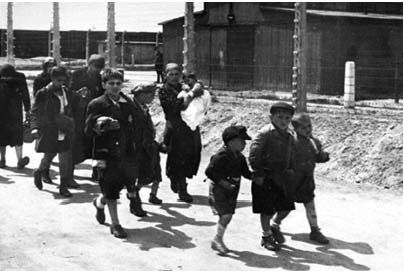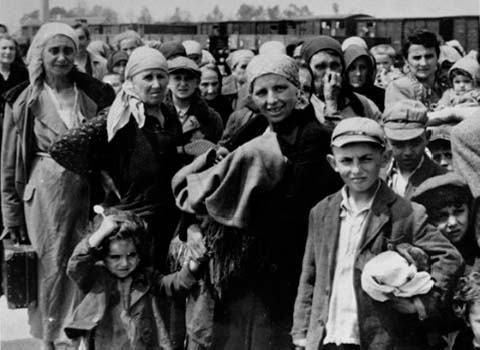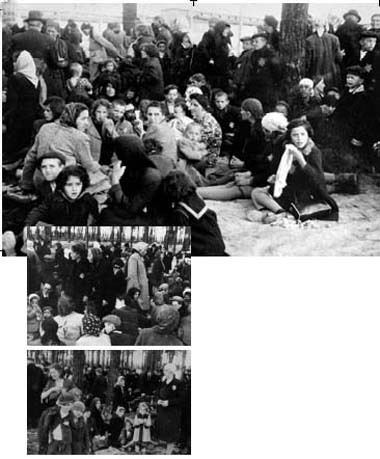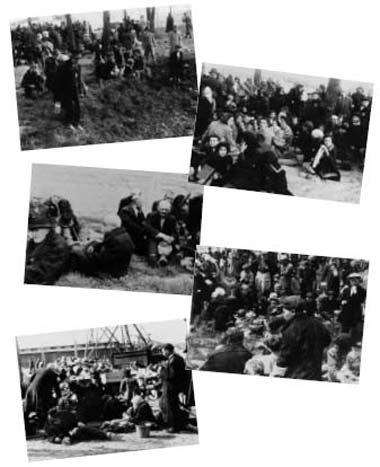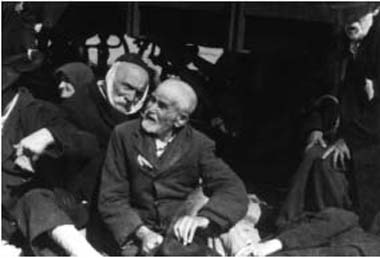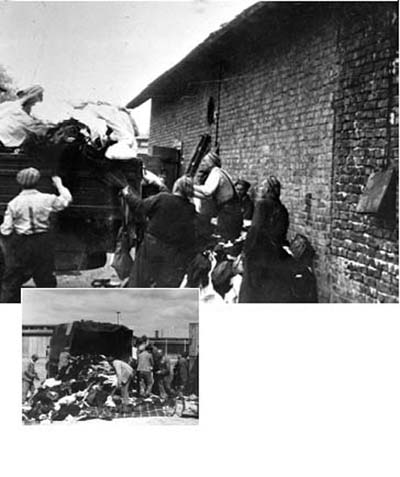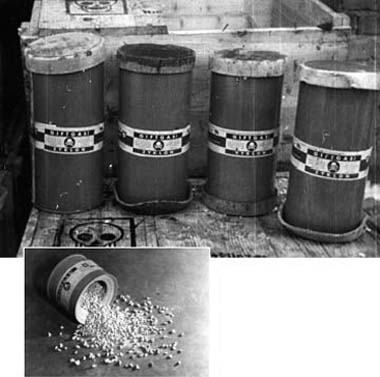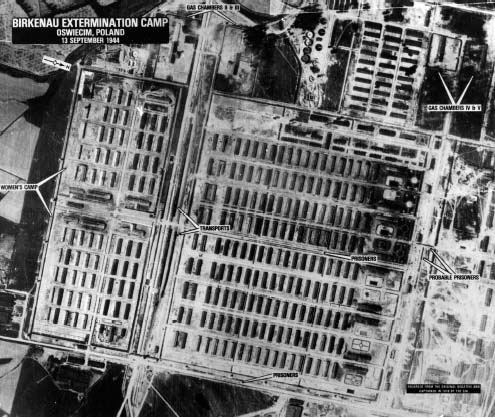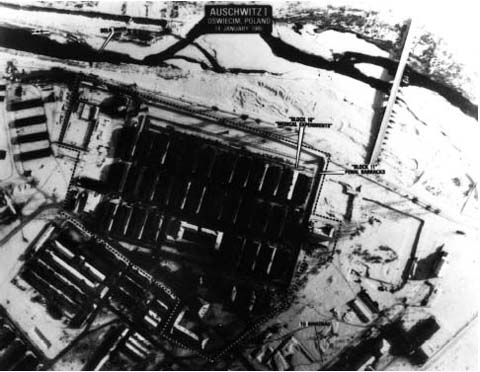The Extermination Centre
The second half of 1942, the SS discussed how best to enlarge camp Birkenau to a capacity of 200,000 inmates. Karl Bischoff had drawn up a plan of the Birkenau site to include two crematoriums, numbered II and III.The crematorium at the main camp was renamed Crematorium I. Another crematorium, known as Crematorium IV was sketched in next to Bunker I, and Crematorium V next to Bunker II. It was estimated that each crematorium had an incineration capacity of 576 corpses a day.To the SS this appeared more than enough to deal with the high volumes that were pouring into the camp. From inception both Crematoria IV and V were to operate as killing centres. They would have their own gas chambers, morgue, and a furnace hall. The other crematoriums would also be transformed to operate as killing machines. Birkenau, it seemed had finally evolved and was now developing into a factory of death.
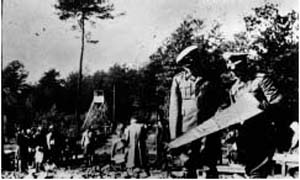
97. Taken in August 1942 showing SS-Sturmbannfhrer Karl Bischoff and SS-Untersturmfhrer Walter Dejaco, head of the drawing office, conferring with the aid of a blue print during the initial stages of construction at the Crematoria IV and V sites. In the background civilian workers probably from the firm Lenz & Co, which specialised mainly in site levelling work. [Courtesy of the Auschwitz-Birkenau Museum]
98. A detailed map showing the Birkenau camp in mid-1944.The drawing shows the railway line travelling through to Crematoria II and III. However, due to restrictions on vital materials because of the war this never reached the killing facilities.Those unloaded would have to walk the short distance to their death instead. [Courtesy of the Auschwitz-Birkenau Museum]
99. An Allied aerial reconnaissance photograph taken on 31 May 1944 showing the I.G. Farben Buna camp at Monowitz.This was the largest of the twenty-eight-satellite camps constructed in the Auschwitz zone of interest. By the end of 1943 some 11,000 prisoners were housed in the Monowitz camp, also known as Auschwitz III. [Courtesy of the Auschwitz-Birkenau Museum]
Whilst plans for the new crematoria were drawn-up, Bunkers I and II continued gassing many more Jews. From all over Europe including Slovakia, France, Belgium and the Netherlands Jewish men, women and children were herded through into Birkenau like cattle and sent to their death.Yet in the midst of this horror Auschwitz during this period was still playing only a minor part in the slaughter of the Jews.The major killing centres were already established in the forests of Poland - Belzec, Sobibor and Treblinka. But the final transformation of Auschwitz came on 26 September. Höss received instructions from SS-Obergruppenführer Oswald Pohl that all possessions belonging to the majority of prisoners entering Auschwitz were to be confiscated for good, labelled and stored. Initially, all possessions had been stored in Block 26 in the main camp, but there was so much looted property that the Auschwitz authorities were compelled to erect six barracks near to the main camp. From these special storage facilities all foreign currency, valuables, gold and other precious metals were authorised to be transported to SS headquarters in Berlin. Usable clothing, shoes, bed linen, blankets, fabrics, household utensils were to be directed to the Ethnic German Liaison Office and distributed for the use of German settlers. As for unusable clothing and other pieces of material these were instructed to be sent directly to the Reich Ministry of Economy and used for the war effort. It was confirmed that the transportation of all these goods were being planned, and with the amount of Jews destined for Auschwitz the yield would be enormous. Many SS officers saw the scheme as a very lucrative enterprise, not just for the Auschwitz authorities and the government in Berlin, but also for those running the camp.
100. Inmates of Birkenau during the construction phase of Crematorium III in late 1942 early 1943. Crematorium III was officially transferred to the camp authorities on 24 June 1943. [Courtesy of the Auschwitz-Birkenau Museum]
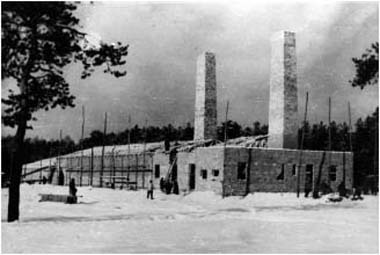
101.The construction of Crematorium IV taken by SS-man Kamann in late 1942.The architects signed off Crematorium IV on 22 March 1943, without having time to test the incinerators. After two weeks of intensive use the double four muffle furnace cracked.The incinerator was decommissioned in May 1943. [Courtesy of the Auschwitz-Birkenau Museum]
102. Prisoners working on the construction site for storage of cabbages in 1944. [Courtesy of the Auschwitz-Birkenau Museum]
But whatever thoughts the SS may have had regarding ‘all the Jewish treasures’, the German authorities were eager to get the construction of the crematoriums installed as quickly as possible. In fact, construction of the crematoriums had already begun in earnest with several hundred workers allocated to building the crematoriums. Despite the massive pool of labour, the Auschwitz construction office knew they would be unable to carry out the building project on its own. Whilst the inmates were capable of building wooden barracks, residential buildings and digging drainage systems, they required civil engineer firms for the actual construction. In total eleven construction companies were involved in the building of all the crematoriums.The civilian firm called Huta from Kattowitz, was already working on the shell of Crematorium II, and then began work on Wednesday 23 September on Crematorium IV. A total of about eighty men worked on the site, sixty or so were prisoners, of which twenty of them worked for the Auschwitz contractor Koehler on building the chimneys. In total between 100 and 150 persons, of whom the majority were prisoners, were employed on the individual work sites. In order to ensure all the firms worked well together a Sonderführer would manage the works in progress and see that the job was completed efficiently and as quickly as possible. For the ensuing weeks and months to come he oversaw firms like Karl Falck from Gleiwitz and the Triton Company from Katowitz that handled the drainage work of Crematoria III, IV, and V. The Klug Company from Gleiwitz which helped Topf and Sons build the furnaces of Crematoria IV and V. Huta who were contracted to complete the floor and walls of the two underground morgues of Crematorium II, whilst the Vedag Company from Breslau, were paid to waterproof the cellars of Crematorium II and III.
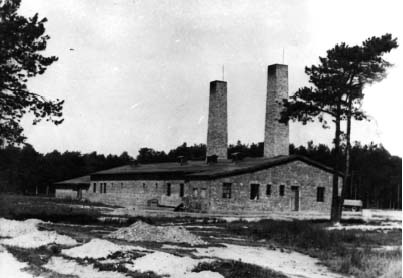
103. A photograph of Crematorium IV. From the time of its inception Crematorium IV was to operate as a killing centre. It had its own gas chamber, a morgue and a furnace hall.Work on Crematorium IV began on 23 September 1942. Nine civilian firms in Upper Silesia participated in the construction of Crematorium IV, which were designated during the construction stage as Bauwerke / Worksites 30b and 30c. The main outer shell of the building was constructed by a firm called Huta of Kattowitz and Reidel & Son of Bielitz; the roof was designed by Konrad Segnitz; the chimneys were built by Robert Koehler of Myslowitz; the external sewers and drains were installed by Karl Falck of Gleiwitz and Triton of Kattowitz. Inside the building the eight-muffle furnaces were built by Josef Kluge of Gleiwitz under the direction of the manufacturers,Topf & Sons of Erfurt. Once completed the building was officially handed over by the Bauleitung to the Camp Administration on 22 March 1943, though some further work was carried out from 24 April to 8 May 1943. [Courtesy of the Auschwitz-Birkenau Museum]
At the end of February 1943 the first of Birkenau’s crematoria, Crematorium II, was finally completed and the five triple-muffle furnaces were to be tested. A few days later on 4 March forty-five ‘well-fleshed’ male corpses specially selected from a batch gassed in Bunker II were transported to Crematorium II.The incineration rooms were on the ground floor, while in the cellar there was a gas chamber and a mortuary. Inside the incineration room the bodies were cremated under the watchful eye of Prüfer and other engineers. For the next ten days the furnaces were run to dry them out whilst engineers completed the gas chamber ventilation system. On Saturday 13 March, it was announced that Crematorium II was officially operational and ready for ‘special treatment’. During the evening of Sunday 14 March, 1,492 women, children, and old people from the Krakow ghetto had been selected for the trial run at Crematorium II. Under the cover of darkness the Jews were quietly led to a temporary undressing hut built next to Crematorium II in its north yard.
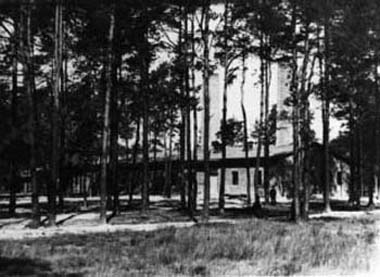
104. Crematorium V in 1943.Work on Crematorium V started on 15 November 1942, and it was officially handed over on 4 April 1943, but it was not actually operational until 18 April and work was not completed on worksite 30c until 22 April. However, during the first weeks of working the furnaces were not operated correctly, being constantly overheated.Topf & Sons blamed the Sonderkommando for deliberately damaging the internal lining with their fire irons. [Courtesy of the Auschwitz-Birkenau Museum]
105. A photograph of the sedimentation basin of BA I, in the summer of 1943. North of the sedimentation basin is Crematorium II with its blackened chimney clearly seen. By mid 1943, it was estimated that Crematoria II and III burned an average of 1,440 bodies per day. [Courtesy of the Auschwitz-Birkenau Museum]
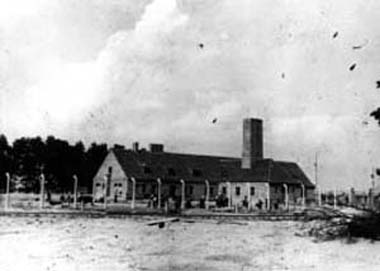
106. Crematorium III probably in the spring of 1944. Reports reveal that between April and September in 1943, Crematorium III worked for only two months at full capacity. Only a quarter of their maximum capacity was utilised. Nonetheless, in the midst of all these technical problems an enormous amount of people were still sent to their deaths. From 25 June 1943 to 27 November 1944, Crematorium III killed about 350,000 victims. [Courtesy of the Auschwitz-Birkenau Museum]
SS officers watched as the Jews under the supervision of the Sonderkommando were ordered to undress, and kindly requested to keep their personal effects together for when they returned.They were then led naked in file down the western stairway, with its metal guard rails to the basement of Crematorium II through a doorway with a sign that read ‘Bath and Disinfection Room’. As they entered the room they could see that from the ceiling hung sieves mounted on pieces of wood or metal, which appeared to be shower heads. Once crammed inside, the airtight door to the room was slammed shut and secured by two latch bars, which were screwed tight. So that the killing process could be observed, there was a specially designed peephole consisting of a double pane of glass.Through this opening the SS watched as 1 or 1.5kg of pale blue-green granulated Zyklon B was poured in from the roof by SS medical orderlies wearing gas masks. It entered the room via four metal-meshed hollow columns that protruded from the concrete ceiling. When the gas was dropped into the room the victims started screaming and panicking, but their death agonies were not heard for long because the Zyklon B used was forty times the lethal dose. In a few minutes, five at the most, the gas chamber fell silent. Once they were sure that all the victims were no longer moving the air extraction system was then switched on for at least twenty or thirty minutes so that it could suck out the poisoned air that was still in the chamber.The gas-tight door was then unbolted and opened, and then the gruesome task of extracting the dead women, children and old people began immediately by the Sonderkommando. It was noted that many of the dead had their eyes still open and were hanging onto one another. Some bodies were crushed by the door, whilst others were found lying around the wire mesh columns. It was quite apparent that many people had tried to escape from the columns, making their way in panic to the doorway. Their bodies were covered with scratches and bruises as the victims trampled one another in frantic effort to escape the gas. Many had blood oozing from their noses and mouths with their faces bloated and blue, and some were so deformed they were unrecognizable. Inside the chamber it was very hot and some, in particular the children probably died of suffocation before the gassing, due to the lack of air. The corpses were then loaded three or four times on a temporary hoist, and sent up to the ground floor. Plans for the installation of an electric elevator had already been drawn-up. Once the bodies arrived on the ground floor of the incinerator room the Sonderkommando attached leather thongs to the bodies and pulled them along the concrete surface through shallow water to a point in front of the furnaces.They were then placed face up head to foot in threes on a metal ‘corpse board’ that ran on rollers and rammed into one of the muffles. It was predicted that the incineration process would probably take between forty-five minutes and one hour, but that evening the incinerators were only being run at half its capacity to prevent any technical problems. In total, preparation and gassing took two hours, but the incineration took nearly forty-eight hours.
107. Prisoners pour concrete for the ceiling of the underground undressing hall of Crematorium II at Auschwitz-Birkenau in the winter of 1943. [Courtesy of the Auschwitz-Birkenau Museum]
108.The construction of Crematorium IV taken by SS-man Kamann in late 1942.The architects signed off Crematorium IV on 22 March 1943, without having time to test the incinerators. After two weeks of intensive use the double four-muffle furnace cracked.The incinerator was decommissioned in May 1943. [Courtesy of the Auschwitz-Birkenau Museum]

109. A photograph of Crematorium IV taken probably in September or October 1942.The main outer shell of the building is clearly being constructed along with one of the Crematorium’s chimneys.The main outer shell of the building was constructed by the firm Huta of Kattowitz and Reidel & Son of Bielitz, whilst the chimneys were built by Robert Koehler of Myslowitz. [Courtesy of the Auschwitz-Birkenau Museum]
110. On the ramp after selection.These Hungarian Jews have been selected for death and wait to be escorted to the Crematoria. In the distance is Crematorium II. On Saturday, 13 March, it was announced that Crematorium II was officially operational and ready to begin administering what the SS referred to as ‘special treatment’. On the evening of Sunday, 14 March, a total of 1,492 women, children, and elderly people from the Krakow ghetto had been selected for the trial run in Crematorium II.That night Jewish prisoners were quietly led to a temporary undressing hut that had been erected next to Crematorium II in the north yard, and then gassed. [Courtesy of the Auschwitz-Birkenau Museum]
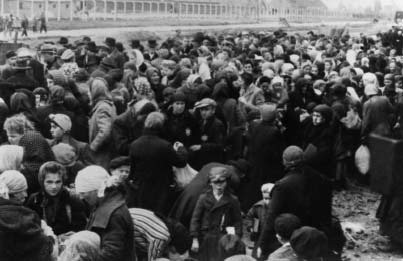
112. A long column of women and children including the old are led away down towards Crematorium II to a fate that can only be imagined. In little under an hour, pending on the volume of people that entered the camp that day, all those regarded as ‘unfit for work’, were led down to the Crematorium and filed into what was known as the central room and undressed there in preparation for gassing. [USHMM - Courtesy of Yad-Vashem Museum]
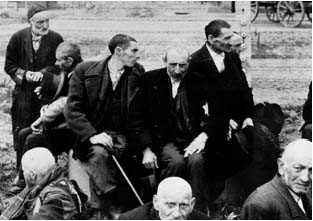
113. Hungarian male Jews wait to be led into the Crematorium and gassed.They are under the impression that they are waiting to be showered and disinfected before rejoining their family and friends. [USHMM - Courtesy of Yad-Vashem Museum]
114.115.116.117. Four photographs showing Hungarian women with their children being led through the camp to the Crematorium to be gassed. Frequently there were so many people that had been selected for death that often long queues were formed, where Jews had to patiently sit or stand around waiting to go through. [USHMM - Courtesy of Yad-Vashem Museum]
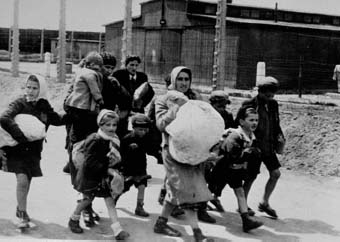
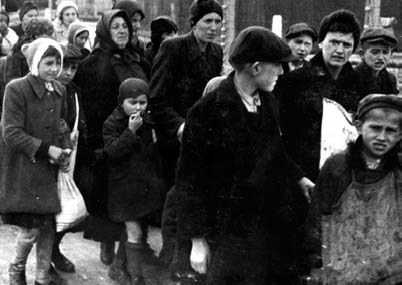
118. On the selection ramp, it is most probable that these old gentlemen would have been deemed ‘unfit’ for labour and sent to their death. [USHMM - Courtesy of Yad-Vashem Museum]
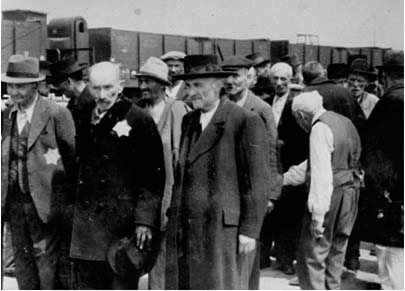
119. Mothers with their children on the selection ramp.Throughout this process the SS tried to maintain an element of calmness in order to reduce panic among the Jews. It was for this reason they decided to reluctantly send perfectly fit mothers to the gas chambers in order to soothe their offspring as they were led into the changing rooms. [USHMM - Courtesy of Yad-Vashem Museum]
120. On the selection ramp, Hungarian Jews are being selected by Nazi doctors. A truck can be seen parked on the ramp in preparation to carry disabled or old people direct to the Crematoriaum without delaying the extermination process. It was also used to transport people’s belongs direct to the Canada buildings. Note in the distance a large column of Jews being led down towards Crematoria II and III. [Courtesy of theAuschwitz-Birkenau Museum]
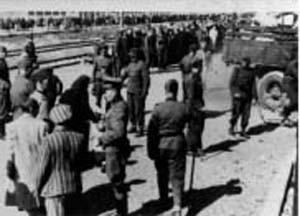
121. On the selection ramp, and this photograph was taken moments before (image 120), showing the selection process. SS officers, guards and Nazi doctors can be seen selecting Jews and ensuring that they join the correct queue. [Courtesy of the Auschwitz-Birkenau Museum]
A few weeks later Crematorium IV was also run simultaneously with Crematorium II. On 4 April, Crematorium V was officially handed over to the camp administration, but the installation was still not deemed fully operational, since the gas-tight doors to the gas chambers were still to be fitted.Work on the doors was completed between 16 and 17 April by a civilian firm working for Huta.There was now a great urgency to complete the other two crematoria. On 24 June, Crematorium III was transferred to the camp authorities. By the end of June Auschwitz-Birkenau had an official daily incineration output of some 4,756 corpses. Yet, despite frequent requests by the engineers not to overload the crematorium, the Auschwitz authorities continued to operate the installations at their absolute limit. By early July the transports to Auschwitz-Birkenau had become much larger and the number of people selected for ‘special treatment’ increased massively.
During July and August recurring problems with the crematoria still continued to hamper operations. With all four crematoria running simultaneously Auschwitz had a massive killing potential, and yet only two were in operation. Crematorium IV was out of service and Crematorium II had temporarily stopped working to be repaired. Crematorium I was closed down altogether at the request of the Political Department, and as for Crematoria III and V, these two installations were running, but at full capacity. Höss attempted everything possible to try and speed up the process of killing, fearing the camp would become quickly overcrowded with those destined for ‘special treatment’. In fact, reports had confirmed that between April and end of September 1943, Crematoria II, III, IV, and V only worked for two months at full capacity. Only a quarter of their maximum capacity was used. Nonetheless, in the midst of all these problems an enormous amount of people were still sent to their deaths in all four crematoria during this time. In total between 160,000 and 210,000 victims were given ‘special treatment’.
122. A tragic image of an elderly lady trudging along a road with children destined for the crematoria in the summer of 1944. [USHMM - Courtesy of Yad-Vashem Museum]
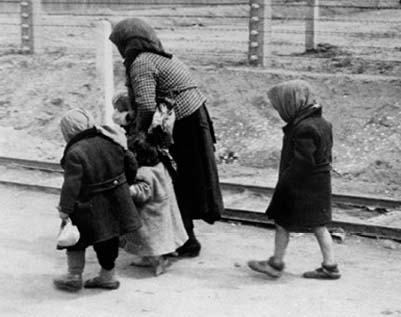
123. 124.125.126.127.128.129.130. Eight photographs showing Hungarian Jews in the summer of 1944, that have been selected to die waiting in the grove of trees by Crematoria IV and V. Scenes like this were a common occurrence at Auschwitz-Birkenau, especially during the liquidation of the Hungarian transports between May and July 1944. During this period roughly 3,300 Jews were arriving in the camp every day, but this figure rose as high as 4,300 on occasion. Although this action was the most sustained mass killing so far in the history of the Auschwitz camp, and was comparable to the scale of murders carried out at Treblinka during July and August of 1942, it was also the most problematic. There were so many Jews that had been selected to die that frequently hundreds of women and children, including the old, had to sit and wait for some considerable time outside the compound of the crematoria before being ordered to undress and be led through the crematoria to their death. [Courtesy of the Auschwitz-Birkenau Museum/ USHMM - Yad-Vashem Museum]
131. A frightened old Jewish women being constrained by three Jewish men is being led in the grove of trees by Crematoria IV and V. [Courtesy of the Auschwitz-BirkenauMuseum]
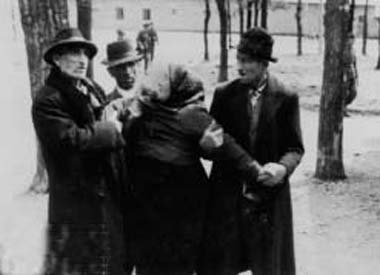
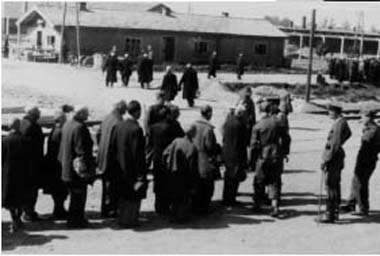
132. A line of male Jews is being assessed by a Nazi doctor. In just a few moments he will decide who lives and who is to die. Everyone to his right is being led away towards Crematorium II. All those chosen to work are rounded up to his left and led down to the Central Sauna for disinfecting and shorning. [USHMM - Courtesy of the Yad-Vashem Museum]
133.There were so many Hungarian Jews destined for the crematoria that even the ramps were occasionally filled with Jews waiting to go through to be gassed. Here in this photograph a group of old Jewish men wait on the ramps next to a stationary cattle truck. [Courtesy of the Auschwitz-Birkenau Museum]
134.A young girl stares at the camera unbeknown to her or her family what fate awaits her.The crematoria dressing rooms were often so full that many Jews had to undress naked in the birch of trees and be led in single file straight into the gas chambers. [Courtesy of the Auschwitz-Birkenau Museum]
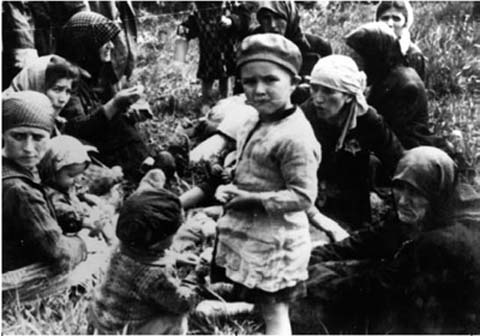
135.136.137.138.139.140.141. Seven photographs showing inmates loading up trucks of the possessions left by Jews on the ramps after the selection process. All these possessions were transported to the camp storage facility known as ‘Canada’. During the first half of 1942 a special storage facility was opened, which the inmates nicknamed ‘Canada,’ and in time this name was adopted by the guards. Canada consisted of six barracks and was situated about 500 metres from the main camp. Some 1,500 prisoners were responsible for sorting through the looted property in shifts. In December 1943, a much bigger warehouse, known as Canada II, was opened on a site between Crematoria II and III and Crematoria IV and V at Birkenau. Canada II comprised thirty permanently overflowing wooden barracks. [Courtesy of the Auschwitz-Birkenau Museum/ USHMM - Yad-Vashem Museum]
142. 143.Two photographs showing the deadly crystallised prussic acid, which was sold in tins labeled ‘Zyklon B’. Depending on the weather conditions, between five and seven kilograms of pale, blue-green granulated Zyklon B would have been poured into the crematoria’s gas chamber by SS medical orderlies wearing gas masks.This quantity of Zyklon B could kill between 1,500 and 2,000 people.The gas entered the room via four metal-meshed hollow columns protruding from the concrete ceiling and would have killed everyone within minutes. [Courtesy of the Auschwitz-Birkenau Museum]
144. An Allied aerial reconnaissance photograph taken on 13 September 1944 showing Auschwitz-Birkenau, also known as Auschwitz II.The photograph clearly identifies all the camp’s crematoria, transport and probable prisoners or camp personnel. [Courtesy of the Auschwitz-Birkenau Museum]
145. An Allied aerial reconnaissance photograph taken on 14 January 1945 showing the main camp Auschwitz I.The Höss family residence house sits at the end of the block barracks nearest to the road overlooking the Sola River. [Courtesy of the Auschwitz-Birkenau Museum]
